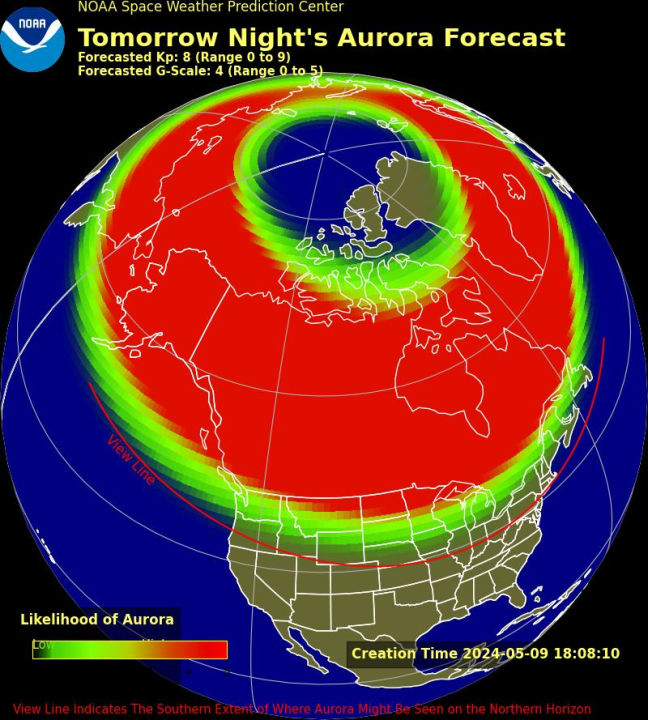Who could see the northern lights amid ‘very rare’ geomagnetic storm watch
(NEXSTAR) — It’s been an active month of solar weather so far, and experts are now predicting we could see the best outcome of all: the northern lights. Current predictions show the aurora may shimmer across much of the U.S., even reaching a rare southern extent.
Since the start of May, NOAA’s Space Weather Prediction Center (SWPC) has been tracking numerous solar flares and coronal mass ejections. While none seem to have been as strong as the X5 flare detected on New Year’s Eve, they have sparked multiple geomagnetic storm warnings.
The latest coronal mass ejections, or CMEs, were so strong, it prompted the SWPC to issue a G4 geomagnetic storm watch on Thursday ahead of their anticipated arrival. This warning level is “very rare,” the SWPC noted, but it could also spark quite the celestial show in the coming days.
What does this all mean, and will you have a chance to see the northern lights soon? Let’s explain.
What are solar flares and coronal mass ejections?
“A flare is an eruption of energy from the sun that generally lasts minutes to hours,” the SWPC explains. They are classified based on their strengths, according to NASA, using a scale ranging from B-class on the lowest end to C-class, M-class, and finally, X-class. Each letter represents a ten-fold increase in energy output, and there is a scale of 1 to 9 in each class, except for X-class. X-class flares can exceed 9, with the largest-ever recorded being an X45 that occurred in 2003.
Solar flares are often accompanied by coronal mass ejections, or CMEs, which are explosions of plasma and magnetic material from the sun. Bill Murtagh, program coordinator for the SWPC and seasoned space weather forecaster, previously told Nexstar that CMEs are “essentially the Sun shooting a magnet out into space.”
What causes the northern lights?
We have CMEs to thank for the northern lights. When CMEs reach Earth’s magnetic field, they spark a big interaction known as a geomagnetic storm.
According to NASA, CMEs create currents in Earth’s magnetic fields that send particles to the North and South Poles. When those particles interact with oxygen and nitrogen, they can create auroras.

Geomagnetic storms are categorized by the SWPC on a 5-point scale. At the lowest end is G1, which is described as minor storms that can lead to aurora being visible in Maine and Michigan’s Upper Peninsula. A G5 storm, described as extreme, could send the northern lights as far south as Florida and southern Texas.
What does the current geomagnetic storm watch mean?
On Tuesday, the SWPC was already warning of an “increased solar flare risk” from two regions on the sun. By Thursday morning, the SWPC was reporting that both regions had produced X1 level flares and that some had produced multiple CMEs.
As of Thursday afternoon, the SWPC has issued a G4 geomagnetic storm watch, explaining that “the CMEs are anticipated to merge and arrive at Earth by late on May 10th or early on May 11th.”
“The aurora may become visible over much of the northern half of the country, and maybe as far south as Alabama to northern California,” the agency wrote.
We saw a G4 level geomagnetic storm watch issued in March, but the storming reached its peak during the daylight hours in the U.S., meaning most didn’t have the chance to see the aurora.
Who will see the northern lights?
As of Thursday afternoon, the SWPC’s aurora forecast for Friday shows Canada and Alaska will have the best chance of seeing the northern lights. In the continental U.S., those in the northern portions of Washington, Idaho, Montana, Minnesota, Wisconsin, Michigan’s Upper Peninsula, and almost all of North Dakota have the greatest likelihood of seeing the aurora.
Residents living in the southern portions of those states, as well as Oregon, Wyoming, South Dakota, Nebraska, Iowa, Illinois, Indiana, Ohio, Pennsylvania, New York, Connecticut, Rhode Island, Massachusetts, Vermont, New Hampshire, and Maine may also get to see a glimpse of the aurora on their northern horizons.

While the SWPC doesn’t yet have a forecast for Saturday, the Geophysical Institute at the University of Alaska Fairbanks shows the aurora may be visible even further south, stretching into northern portions of Missouri, Kentucky, West Virginia, Maryland, and New Jersey.
That auroral monitor uses data from NOAA; however, it’s often based on long-term predictions, The Associated Press previously reported.
These forecasts don’t take into account cloud cover or local weather conditions. North Dakota, for example, has a chance at partly cloudy skies for the next few days, which could greatly inhibit viewing of the northern lights.
There are other aspects that could reduce visibility as well — like whether the CMEs interact with Earth at all. Space is large, and if they don’t follow just the right path toward our planet, the northern lights may not spark at all. It’s also dependent on timing (like if the aurora-sparking interactions happen during daylight hours in the U.S.).
If you don’t get to see the northern lights this week, there’s a chance you’ll have an opportunity again very soon.
According to NOAA, we’re nearing the peak of Solar Cycle 25, an 11-year period in which the sun flips its north and south poles. During this time, various space weather events can occur that can bring geomagnetic storms — and the northern lights — to us on Earth.
While it can be difficult to tell when exactly the U.S. will have the chance to see the aurora borealis, NOAA does offer single-day and next-day forecasts for potential northern light viewing.
Copyright 2023 Nexstar Media Inc. All rights reserved. This material may not be published, broadcast, rewritten, or redistributed.

